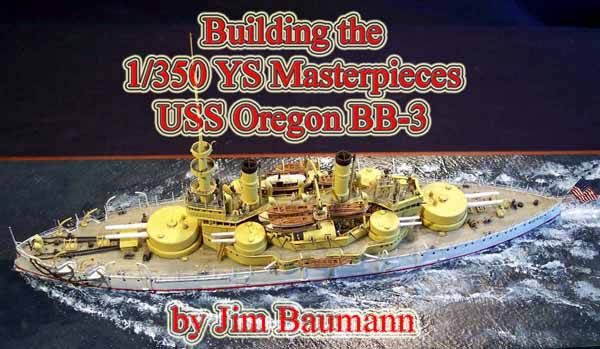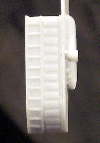

| Oregon was the third unit of the Indiana
class laid down in 19 November 1891 and completed 15 July 1896 at the Union
Iron Works San Francisco.
She served initially on the Pacific Station ; whereupon in mid march 1898 the war with Spain being imminent she was ordered to the East Coast. The voyage from San Francisco in those pre Panama canal days was severely testing trip of some 14,000 miles, during which she nearly foundered on the rocky coastline passing the Straits of Magellan in a very fierce storm. Including coaling stops and head winds she nevertheless made her landfall in Florida after 66 days. She thereafter joined Admiral Sampson fleet off the coast of Cuba to partake in the destruction of Admiral Cervera's fleet at The Battle of Santiago on 3 July 1898. Six enemy ships were destroyed that day, the two most formidable accredited to Oregon. At the end of the war she entered New York Harbor to a gala reception. In 1900 whilst sailing off the coast of China she nearly sank after striking an uncharted rock. Her duties thereafter was relatively uneventful, being regularly overhauled, de-commissioned and decommissioned with her active career culminating in her participation in WW1 in an albeit minor role. As a result of the Washington Treaty she was loaned to the state of
Oregon in 1925 as a floating museum moored at Portland.
In 1944 she was used a a floating ammunition store in support of the re-conquest of Guam in the Pacific. The old hulk remained at Guam post war until in 1948 liberated from her mooring by a Typhoon storm she drifted some 500 miles out to Sea. After being found by search planes she was towed back to Guam where she remained until sold for breaking up in Japan in 1956... So ended the career of McKinley's Bulldog |
||||||||||||||||||||||||||||||||||||||||
Principal Dimensions and Armament
|
||||||||||||||||||||||||||||||||||||||||
| I had purchased both USS Brooklyn and USS Oregon at Telford UK IPMS Nats a few years ago. I chose to build them simultaneously so as to get over the (for me anyhow!) tedious initial stages painting white hulls and butt end penciling of the planks. Having previously built the Glencoe 1/225 Plastic kit of the Oregon I was upon opening of the kit box somewhat bemused by the diminutive size of the hull casting... however any odd thoughts were immediately dispelled by the sheer quality of the casting and photoetch frets. | Click images
to enlarge |
|||||||||||||||||||||||||||||||||||||||
 |
||||||||||||||||||||||||||||||||||||||||
| So I embarked on building both kits at the same time, however after the initial white coats and the decking was completed the longer tumble homed Brooklyn with her loft stacks won my heart and she was completed whilst Oregon languished in her box. Many 1/700 models were subsequently built , until my fancy turned to a 'quick' and 'easy' 1/350 build Oregon was natural choice her hull painting and decks were complete. | ||||||||||||||||||||||||||||||||||||||||
| --alas she was such a squat stumpy ship my enthusiasm was not 100% until I acquired a beautiful (and expensive!) colorized period postcard showing Oregon in her post 1905 configuration with the raised stacks, white gun barrels and WT aerials- I was ready to go-the taller funnels made her look more purposeful and elegant . Oregon carried a number of variations of the buff and white scheme; the white barrels I felt were a welcome contrast . |  |
|||||||||||||||||||||||||||||||||||||||
| I had in the meantime also bought a set of 13" and 8" custom-made
brass gun barrels from Steve Nuttal. These required the underside of the
turrets to be ground out so as to have the gun barrels cemented within
the turret housing allowing the aperture on the fwd face of the turret
to be truly pierced. This was a little fraught as well as risky in the
ever-present danger of breaking through the turret roof with the motor
tool. The superb quality (and non resin warping peace of mind!) made this
operation well worth while.
The pilothouse was supplied as a solid casting, |
 |
|||||||||||||||||||||||||||||||||||||||
 |
||||||||||||||||||||||||||||||||||||||||
 |
||||||||||||||||||||||||||||||||||||||||
| Previous experience with the Brooklyn build made me want to have a see-thru bridge this time . PLAN AHEAD! ensure you have something suitable to manufacture the window frames from before destroying the resin casting I spent a considerable time searching for something suitable I ended using 4 mm scale 00 relief etched Model Railway signal post ladder stock. This was later flush glazed using Krystal Klea |  |
|||||||||||||||||||||||||||||||||||||||
 |
||||||||||||||||||||||||||||||||||||||||
| This also meant that the lower end of the conical military mast would
be visible within the bridge area-- the supplied resin item now being too
short. I was very fortunate to have my friend Steve Folks to create a new
longer cone of Bronze turned on a lathe.
He also made for me the long tapered top mast in stainless steel which would resist tension of rigging superbly as I found out later. Thank You! |
 |
|||||||||||||||||||||||||||||||||||||||
| One of the outstanding features of the Photoetch fret was the delightfully intricate (if very fiddle!) brass assembly of the I section boat skid beams. Less masochistic modelers may wish to substitute these with Plastruct styrene I-girders; despite the brass versions being almost entirely obscured by the ships boats they are sufficiently visible for me to persevere with them! |  |
|||||||||||||||||||||||||||||||||||||||
| It is also essential to carefully read the excellent instruction booklet this will prevent having to install the gunners platforms retrospectively under the boat skids. |  |
|||||||||||||||||||||||||||||||||||||||
| The new taller stacks were scratchbuilt of brass tube, styrene strip and gummed tape. |  |
|||||||||||||||||||||||||||||||||||||||
 |
||||||||||||||||||||||||||||||||||||||||
| A new styrene pilothouse roof was made and installed together
with the tapered mast , the final gap filling being done with white glue.
The upper platform was made using the fine kit PE floor and WEM superfine handrail. |
 |
|||||||||||||||||||||||||||||||||||||||
 |
||||||||||||||||||||||||||||||||||||||||
| Oregon in company with many ships of that era was liberally festooned
with tall bell mouthed cowl vents . These cast items were further re-fined
by thinning the edges and grinding out a bigger opening and drilling down
the shaft with various bits in the Dremel motor tool.
Scheina in the American BB 1886-1923 draws particular attention to the aft vent stack; this had its top 'lid' made from a Model Railway N-gauge buffer! |
 |
|||||||||||||||||||||||||||||||||||||||
| To be able to equip the Oregon with the full complement of cowls as found in her later years as I was portraying her two more cowl vents were needed, these were 'liberated' from a donor Airfix Mauritania kit an excellent source. |  |
|||||||||||||||||||||||||||||||||||||||
| As well a having many many cowls the ship was also littered
with boats of various sizes, all supplied in the kit as resin shells with
PE fret for rudders, oars and thwarts.
the real boats however all had a timber rubbing strake this was re-created using RC Cammett tape and brush painted, relief and crisp paint demarcation in one go! |
 |
|||||||||||||||||||||||||||||||||||||||
 |
||||||||||||||||||||||||||||||||||||||||
The steam launches had a canopy of canvas over frame hoops
the frames for which were supplied as PE items , these frames when installed
were then outlined with stretched sprue and in-filled with white glue thus
giving a fair rendition of the canvas covers which 'hollow' out between
the frames . The photo sequence hopefully explains.
|
||||||||||||||||||||||||||||||||||||||||
| The model was secured to her base to prevent future resin warping with large pozidrive screws through the gun turret barrettes. |  |
|||||||||||||||||||||||||||||||||||||||
| The coal scuttles were represented by using Model Railway rivets let into pre drilled countersunk holes this made the painting of round shapes MUCH easier. |  |
|||||||||||||||||||||||||||||||||||||||
| The fore deck had (according to photos) a chain way liner in metal this was absent from the kit hence I replicated these using the RC Cammett tape- a crisp result with minimum thickness build-up. |  |
|||||||||||||||||||||||||||||||||||||||
| At the other end of the ship there were prominent mooring line fairleads these were made using an individual link from a brass chain with the top cut out, the base being built up with white glue . |  |
|||||||||||||||||||||||||||||||||||||||
| The large admiralty type anchors had the balance weights
made of white glue to form the balls, the anchor handling davits and all
boat davits were made of wire, the pulley blocks added from PE aircraft
wheels...
Although the handrails supplied were quite good I elected to substitute them for the extraordinarily fine relief etched drooped chain items from the WEM Koenig set these were painted black before dry brushing so as to give the impression of the chain links casting shadow. The deck edge awning stanchions on the real vessel mounted outboard of the railings below the turn of the deck edge. This needed a bit of thought --particularly to achieve identical repeatability I chose to cut up over scale 1/350 railings leaving a small stub from the stanchion. These were glued into 'notches' cut into the hull side using a Stanley knife blade levered off the sea base. These photos should clarify...
|
||||||||||||||||||||||||||||||||||||||||
| The bow shield was supplied as a very fine piece of relief etched brass PE--I felt that trying to paint it crisply was beyond my skills so I made a new one cobbled together using parts of various US Flag decals from ISW. The model is extensively crewed by the superb 3 dimensional resin figures from L'Arsenal these are a joy to paint and place they add so much to the realism as well as giving the viewer a sense of scale. | ||||||||||||||||||||||||||||||||||||||||
| My USS Oregon was painted using Humbrol matt white and WEM Soviet aircraft brown for the buff, decks were painted with random tan and drybrushed with WEM teak. | ||||||||||||||||||||||||||||||||||||||||
My usual method watercolor paper and white glue made the
sea---to show Oregon proceeding at half ahead...
In conclusion the YS masterpieces kit would build into a very fine kit
out of the (relatively expensive) box; it again proves the old adage that
one gets what one pays for. The casting quality impresses throughout the
alterations were mainly because I moved the time frame of the model portrayed..
It really was a ' quick and easy' build --for a variety of reasons I involuntarily
stretched it out over nearly a (for me !") long build time of nearly 3
months!!!
My thanks must go out to Chris Eddy who supplied me with a huge amount
of photocopies of various Oregon build articles from a variety of Magazines,
and Gary Kingzett for his helpful advice on detail parts.
Books used for superb photos as well as background:
|
||||||||||||||||||||||||||||||||||||||||
 More
about the author can be found in the Jim
Baumann gallery More
about the author can be found in the Jim
Baumann gallery |
||||||||||||||||||||||||||||||||||||||||